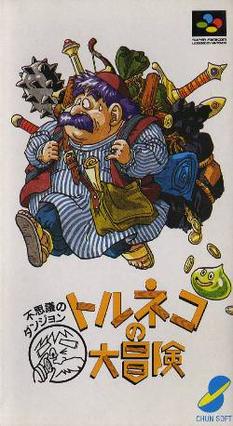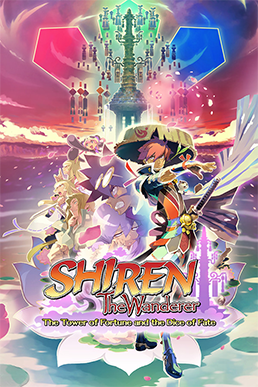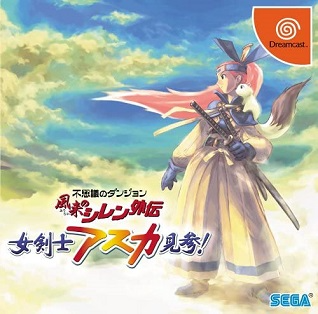Mystery Dungeon, known in Japan as Fushigi no Dungeon, is a series of roguelike role-playing video games. Most were developed by Chunsoft, now Spike Chunsoft since the merging in 2012, and select games were developed by other companies with Chunsoft's permission. The series began when co–creator of Dragon Quest, Koichi Nakamura, was inspired by Seiichiro Nagahata's experience with Rogue, who is also a fellow developer from the company, and a desire to create an original series. It began on the Super Famicom, progressing to almost all of Nintendo's and Sony's home and handheld consoles, WonderSwan, Dreamcast, Windows, and mobile devices.

Shiren the Wanderer 2: Shiren's Castle and the Oni Invasion is a 2000 role-playing video game developed by Chunsoft and published by Nintendo for the Nintendo 64. It is the second main entry in the Shiren the Wanderer series, itself part of the larger Mystery Dungeon series, and was released in Japan on September 27. The game follows Shiren, a boy who aims to defend a village from attacking demons by building a castle; he finds building materials and other items by exploring dungeons.

Mystery Dungeon: Shiren the Wanderer, originally released in Japan as Fushigi no Dungeon 2: Fūrai no Shiren, is a roguelike video game developed and published by Chunsoft. It is the second entry in the Mystery Dungeon series, following 1993's Torneko no Daibōken. It was originally released for the Super Famicom in 1995 in Japan. Sega published a Nintendo DS remake in 2006 in Japan and in 2008 internationally. The remake was later ported to iOS and Android and published by Spike Chunsoft in 2019.

Torneko's Great Adventure: Mystery Dungeon is a 1993 role-playing video game by Chunsoft. The first entry in the Mystery Dungeon series, the game features Torneko, a merchant from Dragon Quest IV, and his adventures around the Mystery Dungeon in search of items.

Pokémon Mystery Dungeon is a video game series spin-off from the main Pokémon series developed by Spike Chunsoft. The games feature the fictional creatures called Pokémon who have the ability to speak human language navigating through a randomly generated dungeon using turn-based moves, indicative of Mystery Dungeon games. As of March 2020, there have been eleven games across five platforms, as well as several manga adaptations and animated specials.

Shiren the Wanderer is a roguelike video game developed by Chunsoft for the Wii. It was released in Japan on June 5, 2008, and in North America on February 9, 2010. A PlayStation Portable version was released later in 2010.

Pokémon Mystery Dungeon: Explorers of Sky is an enhanced version of Pokémon Mystery Dungeon: Explorers of Time and Explorers of Darkness released for the Nintendo DS in 2009, developed by Chunsoft and published by The Pokémon Company and Nintendo. As a sister game, and sometimes referred to as the definitive edition to the aforementioned games, additional features include the addition of the missing Generation IV Pokémon, further character development for a few side characters in content known as Special Episodes, and a few quality of life improvement for options, items, and other gameplay related features.

Etrian Mystery Dungeon is a role-playing video game for the Nintendo 3DS. It was developed by Spike Chunsoft and Atlus, and published by Atlus in Japan on March 5, 2015 and Atlus USA in North America on April 7. It was published by NIS America in Europe on September 11. The game is a crossover between Atlus' Etrian Odyssey series and Spike Chunsoft's Mystery Dungeon series. A sequel, Etrian Mystery Dungeon 2, was released in Japan on August 31, 2017.

Spike Chunsoft Co., Ltd. is a Japanese video game development and localization company specializing in role-playing video games, visual novels and adventure games. The company was founded in 1984 as Chunsoft Co., Ltd. and merged with Spike in 2012. It is owned by Dwango.

Shiren the Wanderer: The Tower of Fortune and the Dice of Fate is a roguelike role-playing video game developed by Chunsoft. It is the fifth main entry in the Shiren the Wanderer series, which is a subset of the larger Mystery Dungeon series. It was originally released for the Nintendo DS in 2010 in Japan.

Shiren the Wanderer 4: The Eye of God and the Devil's Navel is a role-playing video game developed by Chunsoft and published by Spike. It is the fourth main entry in the Shiren the Wanderer series, which itself is a part of the larger Mystery Dungeon series. The game was originally released for the Nintendo DS in 2010; an expanded port was released for the PlayStation Portable in 2012 entitled Mystery Dungeon: Shiren the Wanderer 4 Plus: The Eye of God and the Devil's Navel.

Shiren the Wanderer is a video game series of roguelike and role-playing games developed by Spike Chunsoft. Unlike licensed crossovers within the Mystery Dungeon franchise, this series features original characters; including the eponymous rōnin protagonist Shiren and his traveling companion and talking weasel Koppa, with a plot and the location set generally in feudal Japan, and though indicative of the core games, which is navigating through a randomly generated dungeon using turn-based moves. As of March 2022, there have been multiple games across Nintendo and Sony platforms, mobile devices, Windows, and Steam, as well as few other medias released throughout the years.

The Pokémon Mystery Dungeon: Adventure Team series are three role-playing games released for WiiWare, part of the Pokémon Mystery Dungeon series of games developed by Chunsoft and published by The Pokémon Company. The titles, which were released in Japan on 4 August 2009, are Pokémon Mystery Dungeon: Advance! Fire Adventure Team, Pokémon Mystery Dungeon: Go! Storm Adventure Team and Pokémon Mystery Dungeon: Aim! Light Adventure Team. This installment is the first game in the Mystery Dungeon series to be on a home system, with the next home installment being Pokémon Mystery Dungeon: Rescue Team DX for the Nintendo Switch.

Shiren the Wanderer GB: Monster of Moonlight Village is a roguelike role-playing video game developed by Aquamarine, then by Spike Chunsoft for the Android port of the game, and originally released for the Game Boy by Chunsoft in 1996. It is part of the Mystery Dungeon series. A Microsoft Windows remake, featuring enhanced graphics similar to its previous game on Super Famicom, would be later released in 1999, then re-released later with internet compatibility in 2002. A port of the remake was released on Android in 2011.

Shiren the Wanderer Gaiden: Asuka the Swordswoman is a roguelike role-playing video game developed by Neverland and Chunsoft. It is part of the Mystery Dungeon series, and is a side story based on the Shiren the Wanderer series. It was originally released for the Dreamcast by Sega on February 7, 2002. A Microsoft Windows port would be later released on December 20, 2002 and re-released later with internet compatibility on February 27, 2004, both published by Chunsoft.
Shin-ichiro Tomie is a Japanese game director, writer and part of Spike Chunsoft's affiliation. Since 1995, he contributes to the company with the Mystery Dungeon franchise as the main writer for the Shiren the Wanderer, and Pokémon Mystery Dungeon series. Prior to his affiliation to the company in 1992, he has also contributed in Tecmo's Tecmo Bowl series of sport games.
Kaoru Hasegawa is a Japanese game artist and part of Spike Chunsoft's affiliation. Since 1994, he contributes to the company, with the Mystery Dungeon franchise as the main character designer for the Shiren the Wanderer series since its first title in 1995, and as an artist for other video game titles.

Shiren the Wanderer: The Mystery Dungeon of Serpentcoil Island is an upcoming roguelike role-playing video game developed and published by Spike Chunsoft. It is the sixth main entry in the Shiren the Wanderer series, which is a subset of the larger Mystery Dungeon series, and will be released on Nintendo Switch in early 2024; over 13 years after the last mainline title in Japan, Shiren the Wanderer: The Tower of Fortune and the Dice of Fate, and 8 years in the west.















